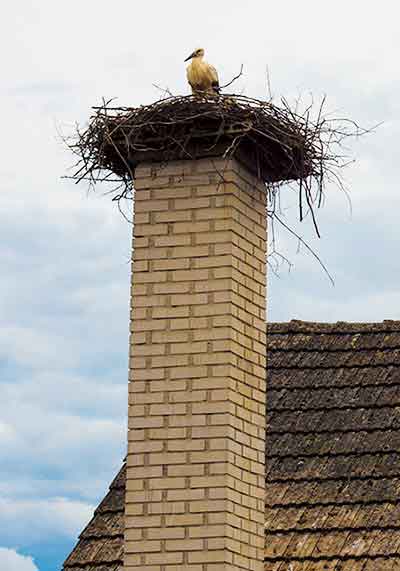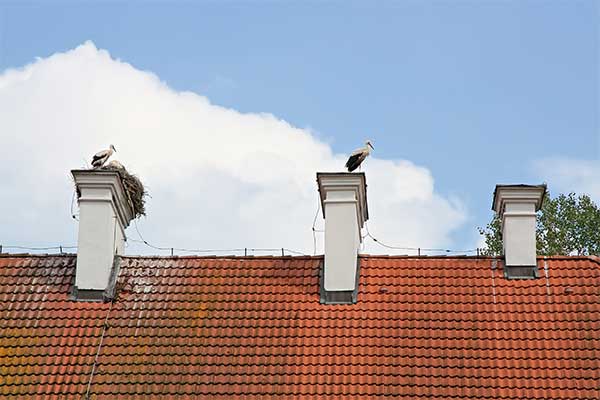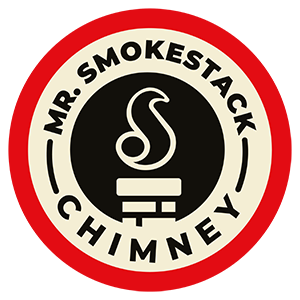Critters in Your Chimney? Hire Mr. Smokestack for Wildlife Removal Services in Raleigh, Durham, Greensboro & More
Wild animals have a few basic needs to ensure their survival – food, water, and shelter. And since we’ve taken up a lot of their natural habitat, it’s not unusual for our living spaces to collide. Your chimney opens to the outside, making it a popular entry point for wild animals to gain access to your home. The chimney is warm and protected, and many animals are attracted to it as a safe haven away from predators – or even as a guarded space to build a nest for their young.
Fortunately for those in Raleigh, Durham, and countless areas surrounding, Mr. Smokestack Chimney Service provides expert and humane wildlife removal services. As chimney care professionals, we know all of the common hiding places and the most vulnerable spots for animals to gain access to your home or attic. If you are having an issue with wildlife intrusion, we will do a complete assessment of your chimney and fireplace to determine the best solution to keeping unwanted animals out.
Call us now at 919-747-1859 or get in touch through our website.
What Types of Animals Commonly Get Stuck in Chimneys?
In North Carolina, we have a wide range of wild animals that could infest your home after sneaking in through the chimney. These animals can get inside your home’s walls or into your attic and become a major nuisance to you and your family. They can damage your plumbing and electrical systems, spread diseases, and simply wreak havoc on the peace and comfort of your home. Some of the most common animals we find in chimneys include:
- Birds
- Bats
- Rodents (rats and mice)
- Opossums
- Squirrels
- Raccoons

How Do I Know if There’s Wildlife in My Chimney?
When it comes to wildlife in your home, the sooner you note it, the better. It’s much simpler to remove a few animals before the situation explodes into a full-blown infestation – two rats can easily create a population of around 1,250 in just one year. Long story short, early detection is important.
Fortunately for homeowners, most wildlife make for terrible roommates and they leave plenty of evidence that they’ve moved in. Here are a few things to keep an eye out for:
- There’s an uptick in animal sightings. Sometimes, you may see the animals themselves, especially if they enter through the fireplace. Rodents are the most likely culprit to use the fireplace to access food sources in your home.
- You hear unusual noises. Animals don’t have a sense of volume control. Wildlife in chimneys can make distinctive sounds. Scratching, scurrying, chirping, flapping, or thumping noises coming from the fireplace or chimney is a good indication that critters have set up shop.
- Foul odors are coming from your fireplace. Unpleasant smells are a calling card for wildlife. The combination of droppings, nests, and food waste can produce distinctive odors. If you suddenly notice a strong, pungent smell, it could be a sign that unwanted guests are present.
- You start finding strange things around the hearth. Animals scavenge for materials to build their nests and you may notice pieces of insulation, leaves, twigs, or other debris collecting in the bottom of the firebox or around the hearth.
- There’s damage to the chimney cap. Check out the chimney cap for signs of damage. Wildlife may try to access the chimney by damaging or knocking off the chimney cap. Missing or broken caps make for easy entry points.
- Smoke backs up into your living space. If your chimney draft suddenly becomes poor when your fireplace is in use, it could be due to a nest or animal blocking airflow. Shine a flashlight up the chimney flue from the fireplace. If you can see an obstruction or notice any eyes reflecting light, close off your fireplace and call Mr. Smokestack Chimney Service.
- There’s unusual activity on your roof. A lot of known chimney pests are nocturnal, meaning they’ll leave the chimney to look for food at dusk and return at dawn. When you take your trash out in the evening or if you’re out for an early morning run, take a good look up at your roofline. You may be able to catch a glimpse of the trespassers in action.
What Are the Risks of Animals Living in My Chimney?
Why is it a big deal if wildlife takes over your chimney? Animals may be cute and seem harmless at first glance, but they invite all sorts of problems into your home.
- They can create a fire hazard. Animals don’t consider fire safety when selecting materials to build their homes. Twigs, leaves, and insulation are some of the most common resources for wildlife when it comes to nest construction, and all of these things are extremely flammable. When you light a fire, it could come into direct contact with a nest if it’s located in a part of the flue that’s close to the firebox. This can then trigger a chimney fire, which leads to all kinds of issues.
- They increase the possibility of carbon monoxide poisoning. An animal or nest can partially or completely block the chimney and stop harmful fumes and gases, like carbon monoxide and smoke, from venting properly. This can lead to a buildup of dangerous fumes in your home, which could be life threatening.
- They can cause structural damage. Animals can damage the chimney structure itself during nesting which can cause deterioration over time. This can lead to costly repairs and compromise the structural integrity of your chimney.
- They disrupt your daily life. Your home should be your sanctuary, but animals don’t care. They make a lot of noise and move around at all hours of the night, which ends up disturbing what should be your peace and quiet time.
- They’re not good for your health. Animal infestations in chimneys can introduce parasites, bacteria, and diseases into your home. Inhaling airborne contaminants from droppings or urine can lead to respiratory issues and other health problems.
How Can I Prevent Wildlife from Entering My Chimney in the Future?
Prevention is always the best option when it comes to your chimney maintenance. Stopping animals from getting into your chimney in the first place is the best way to deal with them. Here’s how to do it:
- Install a chimney cap with a mesh screen. A chimney cap that features a mesh screen – or even a standalone chimney screen – can prevent animals from entering your chimney, while still allowing for proper smoke ventilation. If you have a cap already, make sure that it fits properly and is in good condition.
- Book regular chimney inspections. Schedule a chimney inspection by a professional chimney sweep at least once a year. A chimney technician can identify and address potential entry points and recommend repairs or maintenance, if needed.
- Keep up with chimney repairs. Make sure your chimney is in good condition. Damaged caps, bricks, mortar, and flashing can provide easy openings for animals, so don’t put off repairs if your tech is making recommendations.
- Trim nearby trees and branches. Overhanging branches are basically a highway onto your roof for animals like rats, raccoons, and squirrels. Trim back trees and branches to make it harder for them to reach your chimney.
- Seal your chimney if you don’t use it. If you have multiple chimneys and some are not in use, consider sealing them off with a chimney balloon or cap to keep animals out of your chimney system for good.
Just a few quick and easy steps can prevent a long list of problems. Avoid the headaches – ask us how we can set you up right by calling or booking online with us now.
Is It Safe to Use My Fireplace if There’s Wildlife in the Chimney?
No, you should not use your fireplace if you suspect an animal infestation. Animal nests are typically made of combustible materials like twigs and leaves. When you light a fire, the heat and sparks can ignite the nests, which could potentially lead to a chimney fire.
In addition, it’s unethical. Trying to smoke an animal out will only cause more harm than good, and if the critter gets stuck and passes away, then you’re in no better place than you were before.
If you think you have a wildlife problem, schedule a consultation with Mr. Smokestack Chimney Service by calling 919-747-1859 or contacting us through our website. We’ll recommend a safe option to take care of your critter invasion.

Can I simply light a fire to smoke the animals out?
As mentioned, we don’t recommend this method of animal removal. At Mr. Smokestack Chimney Service, we prioritize the safety and comfort of our clients, but we strongly believe that animal removal should be done as humanely as possible.
A chimney is a small, confined space – lighting a fire in the fireplace will cause distress to the animals in the chimney, and they may panic and attempt to escape. Even worse, exposing wildlife to heat, smoke, and flames could result in harm or death to the animals.
Should I Try to Remove the Animals Myself?
Attempting to remove wildlife from a chimney yourself can be dangerous for both you and the animals. Wild critters are clever and agile. They won’t be easy to get to and will move deeper into the chimney system – or into your home – if they think they’re in danger.
If you don’t have the proper knowledge or experience handling wildlife, you could inadvertently injure or stress them out, especially if they are young or nesting. If there are babies present, the mother will naturally try to protect them and might attack you. Some animals like raccoons and bats may carry diseases or parasites that can be transmitted to humans through bites, scratches, or contact with waste.
Are There Legal Restrictions When Removing Wildlife From Chimneys?
Some wildlife species are protected by local, state, or federal regulations. Chimney swifts are a good example, as they’re one of the more known chimney invaders. Swifts are protected by the Migratory Bird Treaty Act, which means removing or destroying nests with eggs or young hatchlings is a federal offense, punishable by law.
If you have a bird infestation, but you aren’t sure of the species, call us. Our chimney technicians are certified by the Chimney Safety Institute of America (CSIA), and we know how to identify chimney swifts. In most cases, we can’t remove the nests until they’ve voluntarily abandoned them (usually a month after their eggs have hatched), but we can help you manage it, then secure your chimney so the chimney swifts can’t return next season.
How Does Mr. Smokestack Remove Wildlife from Chimneys?
Our removal methods vary depending on the type of animal, if there are babies present, local regulations, and their location in the chimney. No matter what type of removal method we need, you can rest assured that it is safe and is intended to protect the animal. A few techniques we may utilize include:
- One-way doors. Also called one-way exclusion devices, one-way doors are often used for animals like squirrels and raccoons. These devices allow animals to exit the chimney, but stop them from reentering. Once the animals have left, the chimney technician will remove the device and seal the entry point.
- Live traps. Traps are more suitable for animals that can’t easily exit through one-way doors. The traps are placed strategically within the chimney or on the roof to capture the animal safely. Once trapped, the animal can be relocated to a more suitable habitat.
- Removal by hand. In some cases, we may need to physically remove animals from the chimney using specialized tools and protective gear. This method is typically reserved for situations where other removal methods are impractical.
How Much Does Chimney Wildlife Removal Cost?
Without knowing what type of wildlife is living in your chimney and how big the infestation is, it’s hard for us to give an estimate. Once we can clearly identify what animals are in your chimney, and get a full scope of what we have to do to remove them and prevent reentry in the future, we can give you an estimate.
If the critters have been living in your chimney for some time, they may have already caused chimney damage that needs to be repaired to prevent future infestations and make your chimney safe to use. We will go over any recommended repairs as part of your maintenance plan.
If they’ve left behind nests, we’d also suggest a chimney cleaning, which will also affect the overall cost.
You Don’t Have to Live With Unwanted Roommates
At Mr. Smokestack Chimney Service, we pride ourselves on not only removing the animals, but also on taking action so that the animals cannot return. If you think you might have a wildlife problem, it’s important to take care of it right away. The longer the problem persists, the more damage the animals can cause, making it more difficult and dangerous to get rid of them.
Don’t wait – schedule an appointment online or call us at 919-747-1859.
A chimney and fireplace sweeping is one of the most affordable chimney and vent services to schedule for keeping your chimney system working at maximum efficiency.
